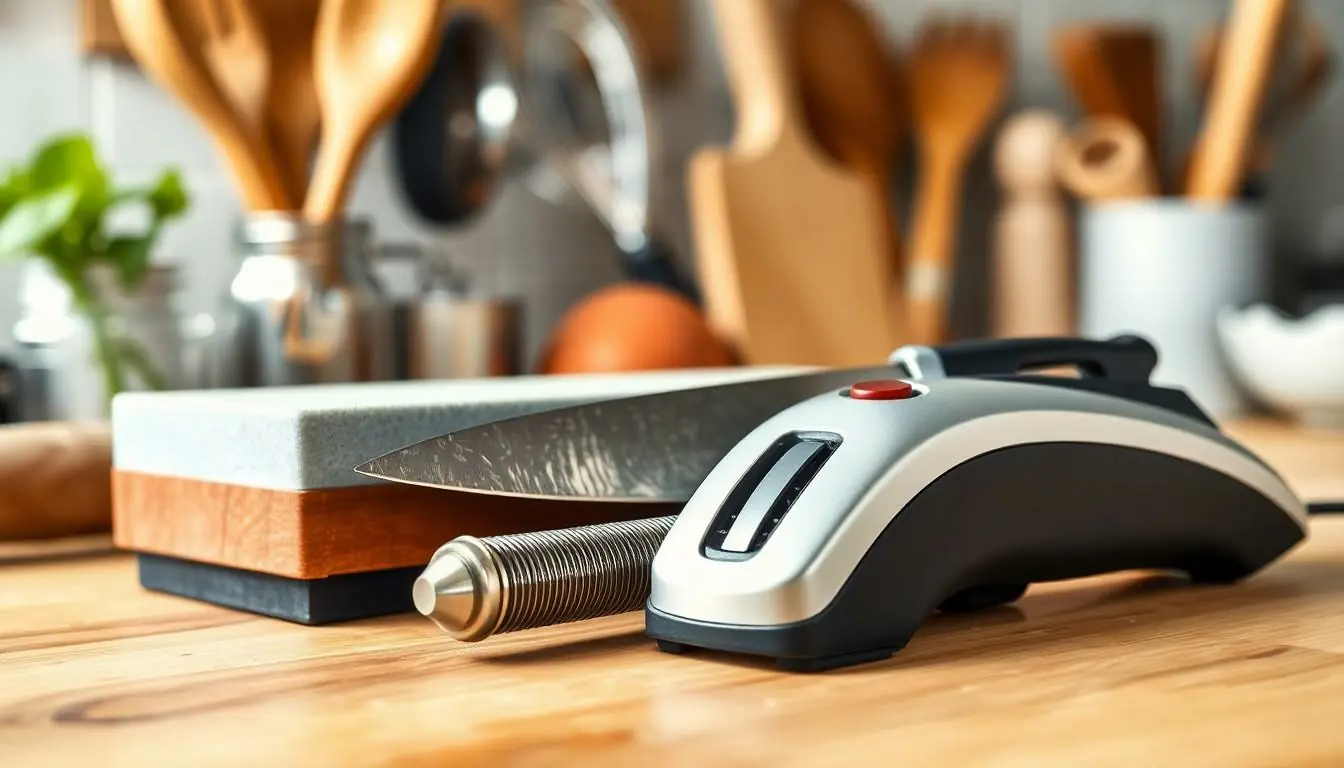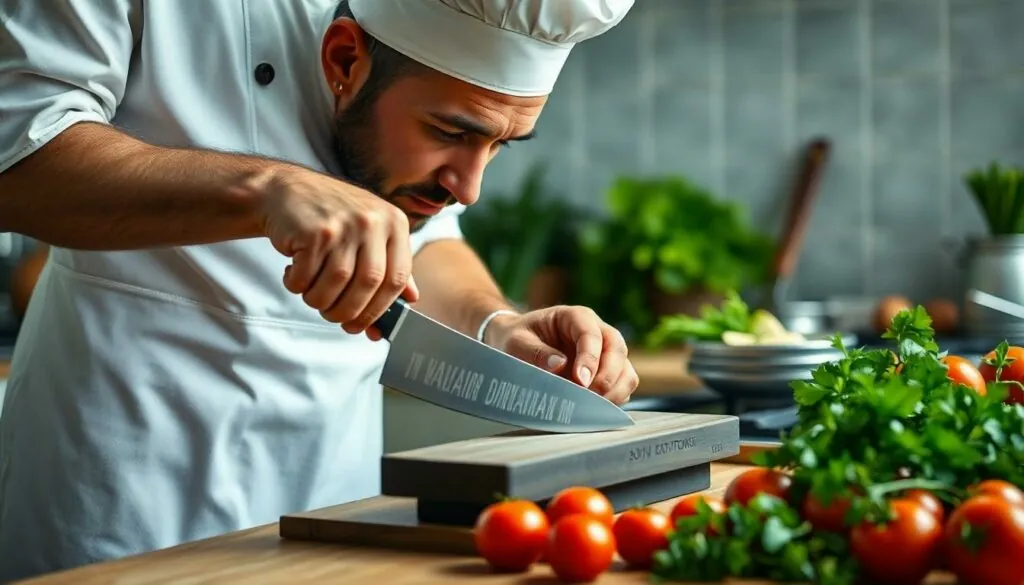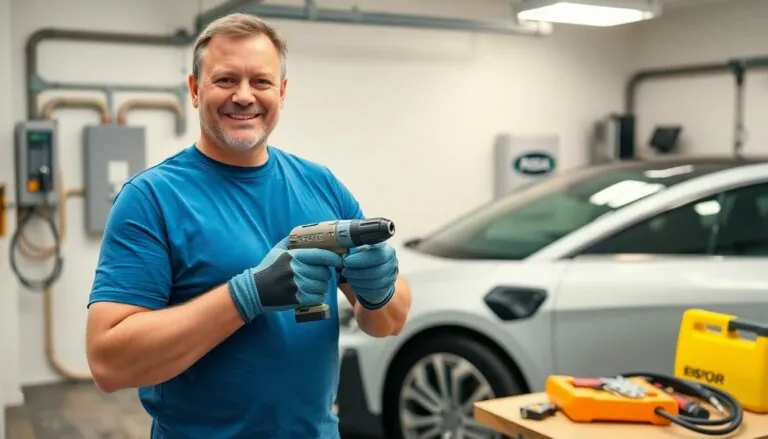Table of Contents
ToggleA dull knife is like a bad joke—nobody wants to deal with it. When it comes to kitchen tasks, a sharp knife is your best friend, making prep work faster and safer. Imagine slicing through tomatoes with the ease of a ninja—no squished fruit or frustrated sighs. Learning how to sharpen a knife at home can transform your culinary experience from “meh” to “wow” in no time.
Understanding Knife Sharpening
Knife sharpening enhances cooking efficiency and safety. A sharp knife simplifies food preparation and improves precision.
Importance of a Sharp Knife
A sharp knife ensures better control during cutting tasks. Dull knives increase the risk of slips and accidents. Food preparation becomes faster, allowing for more enjoyable cooking experiences. Fresh ingredients like herbs and vegetables maintain better textures and flavors when sliced with precision. Additionally, consistent use of a sharp knife reduces fatigue, making meal prep less strenuous. Investing time in keeping knives sharp results in a noticeable difference in culinary skills and outcomes.
Basic Concepts of Knife Sharpening
Understanding the angle is crucial for effective sharpening. Most knives require an angle between 15 to 20 degrees. Sharpening tools like whetstones and honing rods each serve unique purposes. Whetstones refine edges effectively, while honing rods realign blades during regular use. Maintaining regular sharpening schedules extends the life of knives and prevents excessive wear. Practicing proper techniques ensures consistent results, allowing home cooks to achieve professional-grade knife performance. Using the correct method makes all the difference in optimizing cutting efficiency and safety.
Tools You Need

Choosing the right tools simplifies the knife sharpening process at home. Proper equipment ensures effective sharpening while maximizing safety.
Sharpening Stones
Sharpening stones, or whetstones, remain a preferred choice among chefs. These stones come in various grits, allowing for both coarse and fine sharpening. Starting with a lower grit (around 200-600) removes material quickly, while higher grits (around 1000-3000) refine the edge. Maintaining an angle of 15 to 20 degrees during sharpening enhances results. Common materials include ceramic, diamond, and water stones, each offering unique benefits based on the knife type.
Honing Rods
Honing rods play a vital role in maintaining knife edges between sharpenings. Using a honing rod realigns the edge rather than removing material. A 10 to 12-inch rod suits most kitchen knives. Regularly honing prevents knives from dulling quickly, promoting longevity. Choosing a rod made from ceramic or steel helps achieve the desired finish. Incorporating this tool into the routine keeps knives sharp and ready for use.
Electric Sharpeners
Electric sharpeners provide convenience and quick results for home cooks. These devices automate the sharpening process, making it easier for individuals of any skill level. Many models feature multiple stages for sharpening and honing, achieving professional results without extensive effort. Compact designs fit well on countertops or in drawers, adding versatility to kitchen setups. While they offer speed, ensuring compatibility with specific knife types enhances effectiveness.
Step-by-Step Guide to Sharpening a Knife at Home
Sharpening a knife at home involves simple steps that enhance culinary effectiveness. Follow the guidelines below for optimal results.
Preparing Your Workspace
A clean, organized workspace promotes safety while sharpening. Start by clearing the area of clutter and any unnecessary items. Choose a stable surface, such as a countertop, where your knife and tools can rest securely. Gather essential tools, which include a whetstone, honing rod, or knife sharpener. Ensure good lighting to see the knife’s edge clearly during the sharpening process.
Choosing the Right Angle
Selecting the correct sharpening angle greatly affects the knife’s performance. Most kitchen knives require an angle between 15 to 20 degrees. Consider your knife type when determining the angle; Japanese knives typically operate at 15 degrees, while Western knives often sit closer to 20 degrees. Keeping a consistent angle throughout the sharpening process maximizes edge retention and minimizes damage to the blade.
The Sharpening Process
Executing the sharpening process requires focus and technique. Start with the coarser side of the whetstone if the knife has significant dullness. Position the knife at the chosen angle and apply light pressure while sliding the blade across the stone in a sweeping motion. Complete several strokes on one side before repeating on the opposite side. Follow up with finer grit to refine the edge. Regular honing aids in maintaining sharpness, ensuring that the knife remains effective for future use.
Maintenance Tips for Keeping Knives Sharp
Maintaining a knife’s sharpness requires consistent care. Employing a few simple practices can greatly extend knife life and efficiency.
Regular Honing
Regular honing prevents knives from becoming dull. Honing rods help realign the blade’s edge, ensuring optimal cutting performance. Doing this after every few uses keeps knives performing at their best. Each action only requires a few gentle strokes on both sides of the blade. Home cooks often find that this quick task enhances the knife’s overall sharpness. Maintaining this routine allows for smoother cutting and reduces the need for heavier sharpening.
Proper Storage Techniques
Proper storage plays a crucial role in knife maintenance. Keeping knives in a designated block or magnetic strip prevents blades from dulling against other utensils. Wrapping knives in protective sheaths offers added safety for both the blade and the user. When storing knives in drawers, using a knife tray can prevent collisions with other items. These techniques ensure that blades remain sharp and ready for use when needed. Emphasizing careful storage habits contributes to longevity and performance in the kitchen.
Sharpening a knife at home is a skill that can transform the cooking experience. With the right tools and techniques anyone can achieve a sharp blade that enhances both safety and efficiency in the kitchen. Regular maintenance and proper storage are crucial for prolonging the life of knives and ensuring they perform at their best.
By incorporating these practices into their routine home cooks can enjoy the benefits of precision cutting and improved meal preparation. A well-maintained knife not only makes cooking easier but also elevates the overall culinary experience. Investing time in learning how to sharpen a knife will yield significant rewards in the kitchen.







